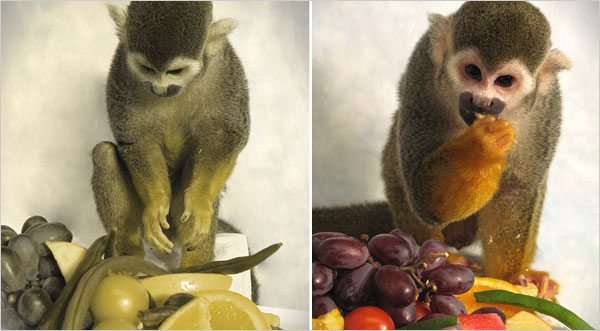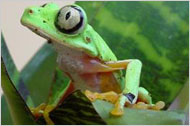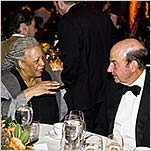Dalton and Sam are male squirrel monkeys, about a foot tall. Their ancestors lived by eating fruit and insects and dodging falcons in the forest canopy of Central and South America. Dalton and Sam lead a more protected life in the laboratory of Jay and Maureen Neitz at the University of Washington, Seattle. Recently, the Neitzes endowed them with a new genetic gift: the ability to see the world with full color vision.
Male squirrel monkeys have only two of the color pigments known as opsins, unlike people who have three. The Neitzes, with Katherine Mancuso and other colleagues, used the technique of gene therapy to introduce the gene for the missing red pigment into the cone cells of the monkeys’ retinas. Several months after the therapy, Dalton and Sam were able to see a world in which red hues were visible and oranges no longer looked like lemons, the researchers say in the current issue of Nature.
Although the monkeys could not report that they saw the world with new eyes, their ability to do so was judged by their performance on a color-vision test with a reward of fruit juice.
Jay Neitz said Dalton was named for John Dalton, who not only invented modern atomic theory but in 1794 was also the first person to describe color blindness — his own.
It was somewhat surprising that the monkeys’ brains could take advantage of a third opsin. The retina, however, seems to work by recording the difference between the signals from neighboring cones, the cells that detect color. So the extra opsin gene given to Dalton and Sam would have changed the signal from affected cones and hence the message forwarded from the retina to the visual cortex in the brain.
The red opsin gene was carried on a standard virus used for gene therapy experiments. Injected into the eye, the virus donated the opsin gene to the monkeys’ cones along with a piece of DNA that directed the cones to make the new red opsin in preference to their own green opsin.
Because some cones were infected by the virus and some were not, the monkeys had both red and green cones at work, in addition to their unaffected blue cones.
Dr. Jeremy Nathans, a molecular biologist at Johns Hopkins University who has genetically engineered a mouse with full color vision, said the monkey experiment would help researchers understand the circuitry used by the primate brain to analyze color. A next step might be to see how the cells in the monkeys’ visual cortex respond to the new signals from the retina, Dr. Nathans said.
New World male monkeys like Dalton and Sam are chromatically challenged because their ancestors split off from Old World primates before full color vision evolved. At the time of the split, primates had only two visual pigments, one that is particularly sensitive to blue light and another that responds best to either green or red, depending on which variant of the gene is inherited.
After the split, which began with the opening of the Atlantic between Africa and South America some 150 million years ago, the Old World primates benefited from a genetic accident. The gene for the red or green opsin was duplicated, allowing individuals to see red and green instead of just one or the other.
New World monkeys never developed the duplicated gene, but many females have full color vision nevertheless. The reason is that the red/green opsin gene lies on the X chromosome, so females who inherit a different version from each parent have both red and green opsins along with the blue opsin on another chromosome. But males, with only one X chromosome, inherit just one variant of the red/green opsin — the green in the case of Dalton and Sam.
















